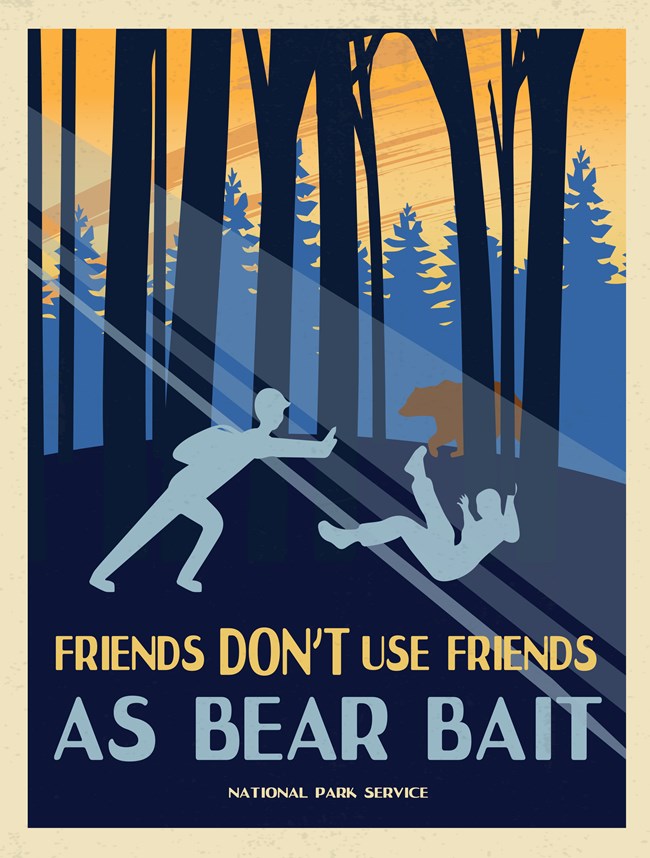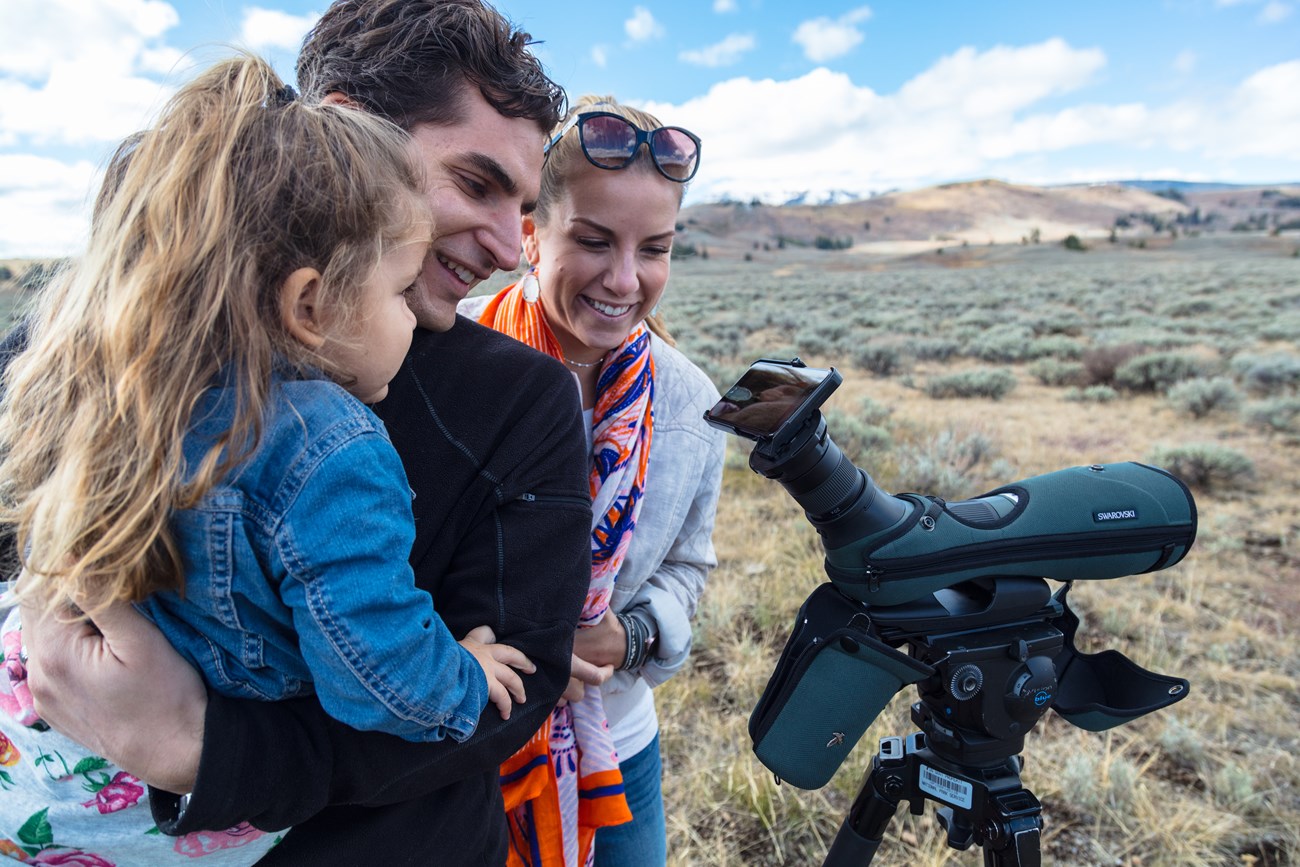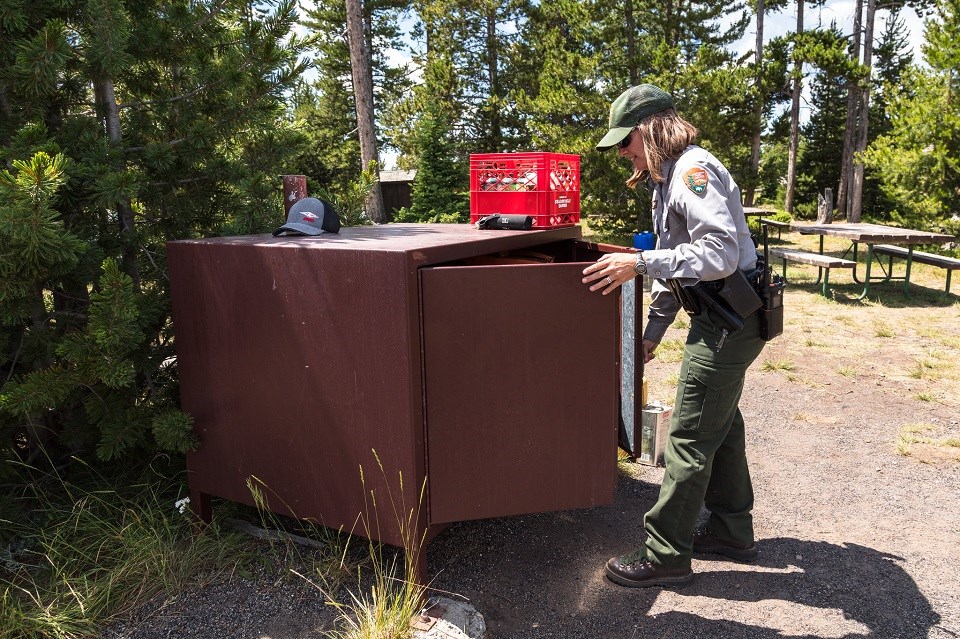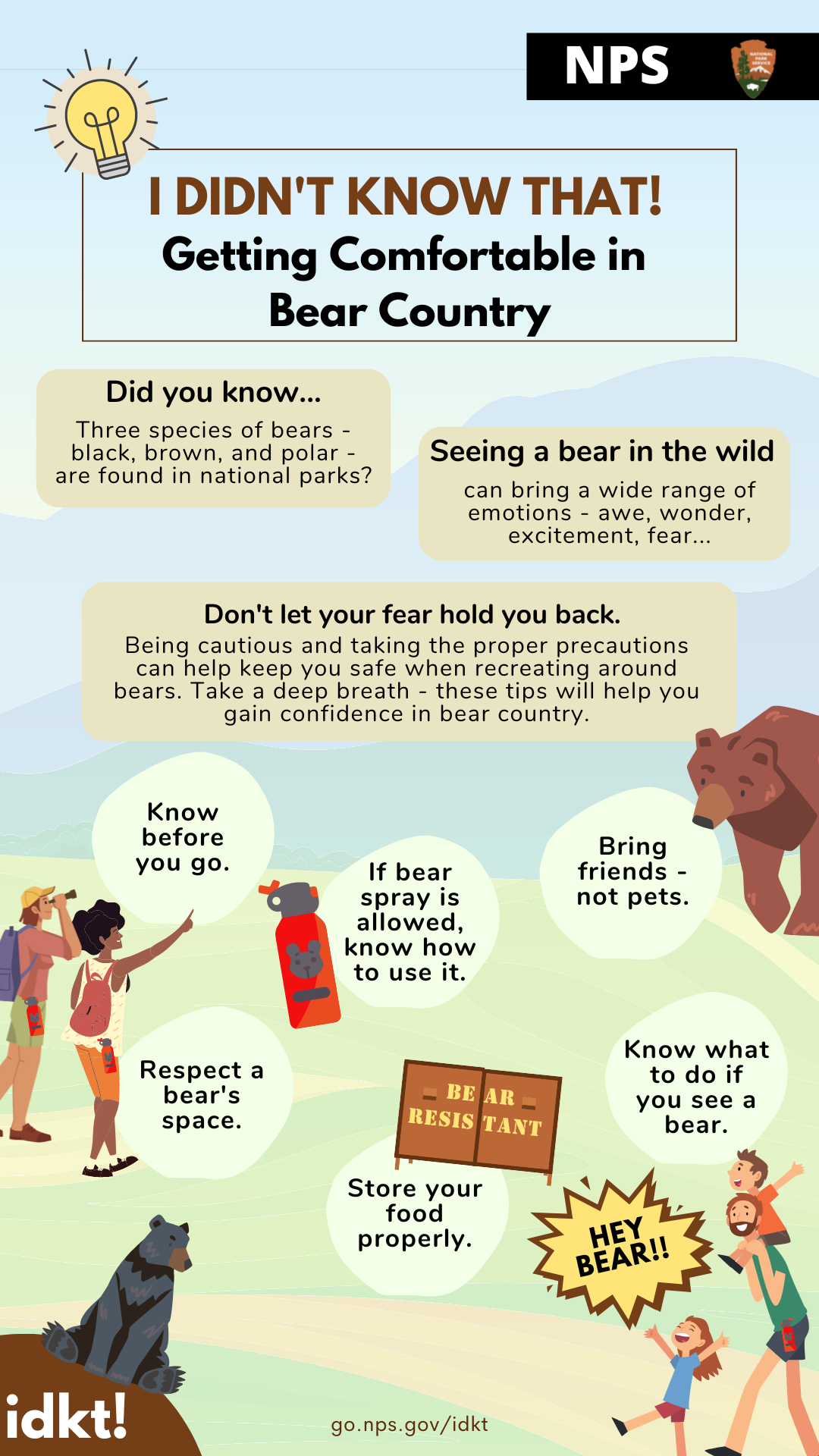Last updated: December 23, 2024
Article
I Didn't Know That! Getting Comfortable in Bear Country

You’re planning your next trip to a park and getting hyped for what is sure to be an epic hike. You have your 10 essentials ready and you’re making sure you know before you go by checking the park website. You’re looking up information about your hike when, your heart-drops... it says your hike is in BEAR COUNTRY! While your brain might immediately say, “ABORT!” take a few deep breaths and we’ll walk you through how to gain confidence and stay safe when recreating in bear country.
Seeing a bear in its natural habitat can bring along a wide range of emotions – awe, wonder, excitement, fear... While you shouldn’t let your fear deter you, being cautious and taking the proper precautions can help keep you safe when recreating around bears.
What You Can Do

Getting ready

NPS
Know Before You Go
Checking park websites and talking with park staff about bear safety and regulations is your first step to staying safe in bear country. Different species of bears behave differently, and the same species of bear may act differently in different environment, so make sure you know before you go.
Bring a friend – and not a furry one
And, no – not just so you can push a slower friend down if you come across a bear (we never recommend using friends as bear bait). In bear country, it's a good idea to make noise! Hiking in groups can help alert a bear to your presence (which is a good thing!). Groups of people are usually noisier and smellier than a single person. Therefore, bears often become aware of groups of people at greater distances, and because of their cumulative size, groups are also intimidating to bears.
If pets are allowed (they’re often not), considering leaving them at home. Barking can cause additional stress during a bear encounter and off-leash dogs can lead bears back to you. Learn more about hiking with pets in national parks.
Bring bear spray and know how to use it
Bear spray is a deterrent for aggressive bears. It’s basically pepper spray on steroids – with a higher concentration of capsaicin (pepper oil) and a longer range. Bear spray is your last line of defense and not a substitute for any of the other bear safety measures.
Having bear spray isn’t useful if you don’t know how to use it! Learn how to use bear spray and practice the movements before you hit the trail. Make sure to carry your bear spray in an accessible place, on your body – not in your pack. And remember, bear spray doesn’t work like insect repellant. Do not spray it on yourself or your gear. You will not have a good time.
- Duration:
- 1 minute, 3 seconds
Bear spray is proven to be highly successful at stopping aggressive behavior in bears. Bear Management Biologist Kerry Gunther walks through the steps to deploy bear spray.
At the Park
Respect a bear’s space
When recreating in bear country, it’s important to remember that you are entering a bear’s home and it’s your responsibility to be a respectful guest. One of the best things you can do to prevent a negative encounter is to give the bear space.

NPS Photo / Neal Herbert
Be bear aware. While recreating in bear country, be alert. Keep an eye out for signs of bear activity – like scat (poop) or tracks. Be aware of places where you might encounter a feeding bear (we’re not the only ones who get excited when we come across a ripe huckleberry patch). Never approach or linger by an animal carcass.
Never approach, crowd, pursue, or displace bears. If a bear changes its behavior because of your presence, you are too close! Also, check with the park you are visiting for viewing distance regulations, which may vary based on species and terrain. For example, Yellowstone National Park requires visitors to keep a distance of at least 100 yards (300 feet); Shenandoah National Park recommends 200 feet or more.
Use your zoom, binoculars, or spotting scopes.
Make noise while hiking. Making noise while hiking can help you avoid startling a bear. Talk to your hiking partners, occasionally sing loudly, yell “hey bear” or clap your hands loudly to let any bears know you’re coming. Make extra noise when you’re close to loud natural features such as rivers, streams, and on windy days. Also make lots of noise when approaching features that make it hard for a bear to see you (such as a crest in the trail or a blind corner).
In some parks (like Yosemite, Sequoia, and Kings Canyon), rangers ask that you scare away any bear you see in a developed area or that is approaching you. To scare a bear away, gather your group together and yell as loudly and aggressively as possible at the bear until it leaves (but don't chase the bear). See how this ranger in Yosemite scares bears away. This advice applies only in specific parks and can be dangerous in other parks, so be sure to check recommendations from every park you visit.
Bear bells may be a popular item to put on your backpack, but they don’t effectively warn a bear you’re in the area. Bears won’t hear the bells until you’re too close. The human voice is the most effective way of alerting bears to your presence.

NPS Photo / Jacob W Frank
Keep your food (and other smelly items) to yourself
Storing your food and disposing of garbage properly can mean life or death to a bear. Bears learn quickly and will return to areas where they find food. Not only can this be dangerous for people, but it is also harmful to bears. Always keep your food (and garbage) within arm’s length or store it properly. And this goes for items that could smell like food to a bear (think tropical scented sunscreen or cherry lip balm).
Know what to do if you see a bear
If you do get the opportunity to see a bear, stay calm! If you’re at a safe distance and the bear is not changing its behavior due to your presence, enjoy the moment. Grab your camera and zoom in for a great photo. If the bear has noticed you and is paying attention to you, find out what you can do to prevent the situation from escalating.

Pass it on!
Did you learn something new? Pass it on! Staying safe while recreating in bear country is a responsibility for us all, but there’s no way for everyone to be an expert in everything. That’s why sharing knowledge is so important!
Download or screenshot this card to share with a friend or help you remember some basics to make you feel more comfortable and confident when recreating in bear country. Thank you for helping protect yourself and the bears.
Check out other I Didn’t Know That! topics.
- Did you know... Three species of bears - black, brown, and polar - are found in national parks?
- Seeing a bear in the wild can brind a wide range of emotions - awe, wonders, excitement, fear...
- Don't let your fear hold you back. Being cautious and taking the proper precautions can help keep you safe when recreating around bears. Take a deep breath - these tips will help you gain confidence in bear country
- Know before you go.
- Bring bear spray - and know how to use it
- Bring friends - not pets
- Respect a bear's space
- Store your food properly
- Know what to do if you see a bear
